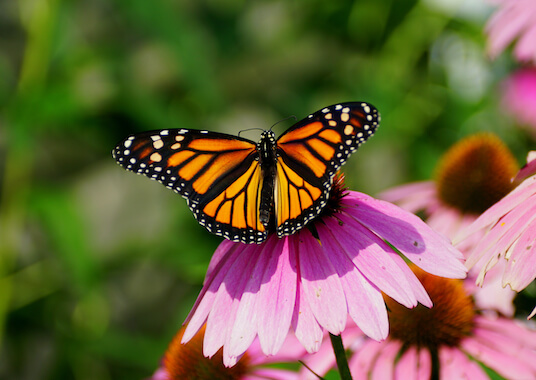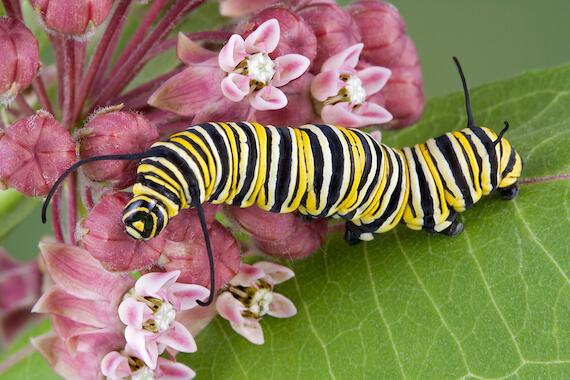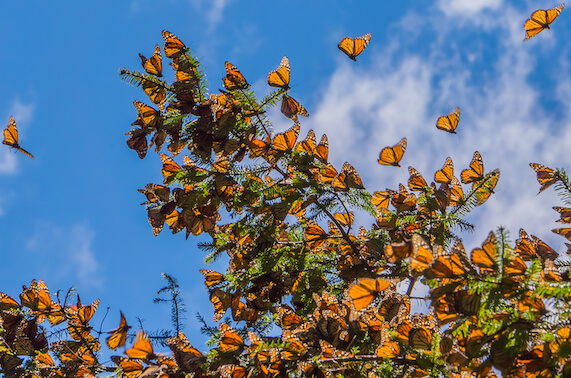
| Kingdom | Animalia |
| Phylum | Arthropoda |
| Class | Insecta |
| Order | Lepidoptera |
| Family | Nymphalidae |
| Genus | Danaus |
| Species | Danaus plexippus |
| Niche | Herbivorous poisonous flying insect |
| Wingspan | 3.5 – 4.0 inches (8.9 – 10.2 cm) |
| Weight | 0.0095 – 0.026 ounces (0.27 – 0.74 g) |
| Lifespan | 2 – 5 weeks |
| Social Structure | Large groups |
| Conservation Status | Least concern |
| Preferred Habitat | Rural areas with access to food sources |
| Average Clutch Size | 300 – 500 eggs |
| Main Food Item | Milkweed & nectar |
| Predators | Birds, mice & other insects |
The Basics
The monarch butterfly is a species of butterfly native to the Americas. Although they are no longer found throughout most of South America, these butterflies have spread to other parts of the world including much of Oceania and even as far as Spain and Portugal. There are two main groups of monarch butterflies in North America, although these are not differentiated enough to be considered as separate species or even subspecies. The western monarchs breed west of the Rocky Mountains and migrate south to spend the winter in southern California, whilst the eastern monarchs breed in the Great Plains and Canada, spending the winter in Central Mexico.
Adult monarch butterflies feed on the nectar of a wide variety of flowering plants. However, their caterpillars only eat the leaves of milkweed plants, thus these butterflies can only breed in areas where milkweed is present. In addition to feeding on nectar, monarch butterflies also partake in a behavior known as mud-puddling. This behavior is most common in butterflies but also occurs in other insects and involves individuals sucking up fluid from damp soil or other wet surfaces to obtain additional moisture and nutrients.

Description
Monarch butterflies have orange wings with black veins and edges. The black edges exhibit two rows of white spots, along with some orange spots near the tips of the forewings. The undersides of monarch butterfly wings are more of a yellow-brown color than the upper sides and have larger white spots. The appearance of these butterflies changes slightly throughout the year, with earlier migrants having wings that are more red and elongated than later migrants. Appearance also varies across the range of the monarch butterfly, as populations in eastern North America have larger, more angular forewings than those in western North America.
Monarch butterflies are closely related to two other species of butterfly also found in the Americas. The southern monarch is native to tropical and subtropical regions of South America and looks so similar to the monarch that until recently it was considered only to be a subspecies of this butterfly. The Jamaican monarch is native to the Dominican Republic, Haiti and Jamaica and is smaller and darker in color than the other two monarch species. There are also a number of subspecies of monarch butterfly, although exact classifications are still under debate.
Life Cycle
The life cycle of the monarch butterfly comprises four stages of complete metamorphosis. Females lay tiny eggs individually on the undersides of milkweed leaves, which hatch after 3 – 8 days. After emerging from their eggs, caterpillars consume large amounts of milkweed leaves to increase their mass in preparation for pupation. Monarch caterpillars undergo five stages of growth lasting 3 – 5 days each and moult at the end of each stage. Once they reach the final stage, caterpillars are generally 2,000 times heavier than they were in the first stage and have increased in length from 2 – 6 mm to 2.5 – 4.5 cm.
At the end of the fifth stage of growth, monarch caterpillars stop eating and search for a pupation site. Here, they attach themselves to the underside of a branch with their hindlegs and hang for a few hours before shedding their skin to reveal a green chrysalis. At first the exoskeleton is soft, but hardens within a day. The chrysalis normally matures in 11 – 12 days, becoming completely transparent just before the butterfly is due to emerge. After the adult butterfly emerges, it hangs upside down for a few hours whilst its wings dry out. Fluid is pumped into the wings to help them expand and stiffen.

Fun Facts about Monarch Butterflies
Monarch butterflies are not only beautiful to look at, but also provide insights into a number of interesting biological concepts.
Unpalatable Prey
Both adult monarch butterflies and caterpillars are aposematic, exhibiting conspicuous warning coloration that signals this animal’s foul taste and poisonous nature to potential predators. Aposematic coloration is common amongst poisonous or stinging animals such as poison dart frogs and wasps. This trait is beneficial because potential predators learn not to eat poisonous animals based on their coloration, thus protecting both prey and predators from harm.
Monarch butterflies derive their poison from the milkweed leaves they eat as caterpillars. These leaves are toxic due to the presence of a collection of molecules called cardenolides, however monarch butterflies and other insects such as the milkweed bug have evolved a resistance to these molecules and can tolerate them in much higher concentrations than other animals. Monarch butterflies have adapted to take advantage of this resistance by storing the cardenolides in their bodies, therefore making them unpalatable and poisonous.
Migration
Monarch butterflies migrate annually between their northern breeding grounds and their southern overwintering grounds, with some populations travelling as far as 3,000 miles (4,828 km) each way. The southerly migration occurs in late summer or early autumn and is completed by a single generation of butterflies. Most monarch butterflies become sexually mature around 4 – 5 days after they emerge and only live for 2 – 5 weeks. However, the migratory generation does not become sexually mature until overwintering is complete, thus these butterflies can live for up to 9 months.

Butterflies in the migratory generation spend winter huddled together on fir trees. Once spring arrives, they begin the journey back north, but do not complete this journey themselves. Instead, they only travel part of the way before stopping to lay eggs that will develop into the next generation. This generation then continues the migration before stopping to lay its own eggs. The process repeats in this way for up to 4 or 5 generations before the butterflies finally reach their breeding grounds.
White Monarch Butterflies
The monarch butterfly’s orange and black wings are a consistent feature of this animal throughout its range. However, on the island of Oahu in Hawaii, there exists a rare white form, known as the nivosus morph, which is found at a frequency ranging from 1 – 8%. Although individual white monarch butterflies have been reported at numerous locations across this species’ range, Oahu is the only location where a stable nivosus population is known to be maintained.
Given that the typical orange and black coloration of monarch butterflies protects them from predators, increased predation of white morphs might prevent the formation of stable nivosus populations across the majority of the monarch’s range. However, the white morph actually experiences lower levels of predation than the orange form on Oahu. This is because the most common insectivorous birds on this island, two species of bulbul, are likely tolerant to the monarch butterfly’s poison and are known to prey on both caterpillars and resting adults. Therefore, white morphs might have a selective advantage in this case because predators recognize the orange butterflies as prey, but not the white ones.
